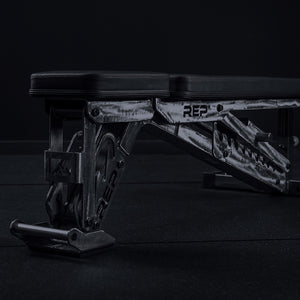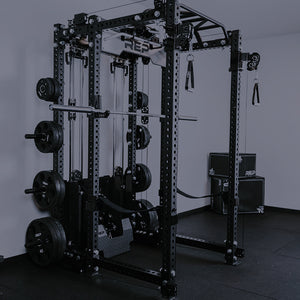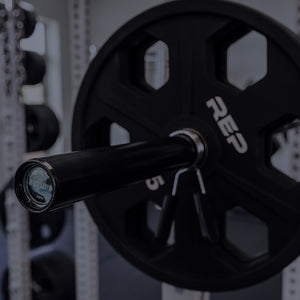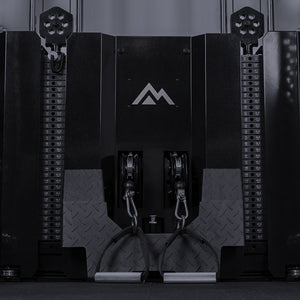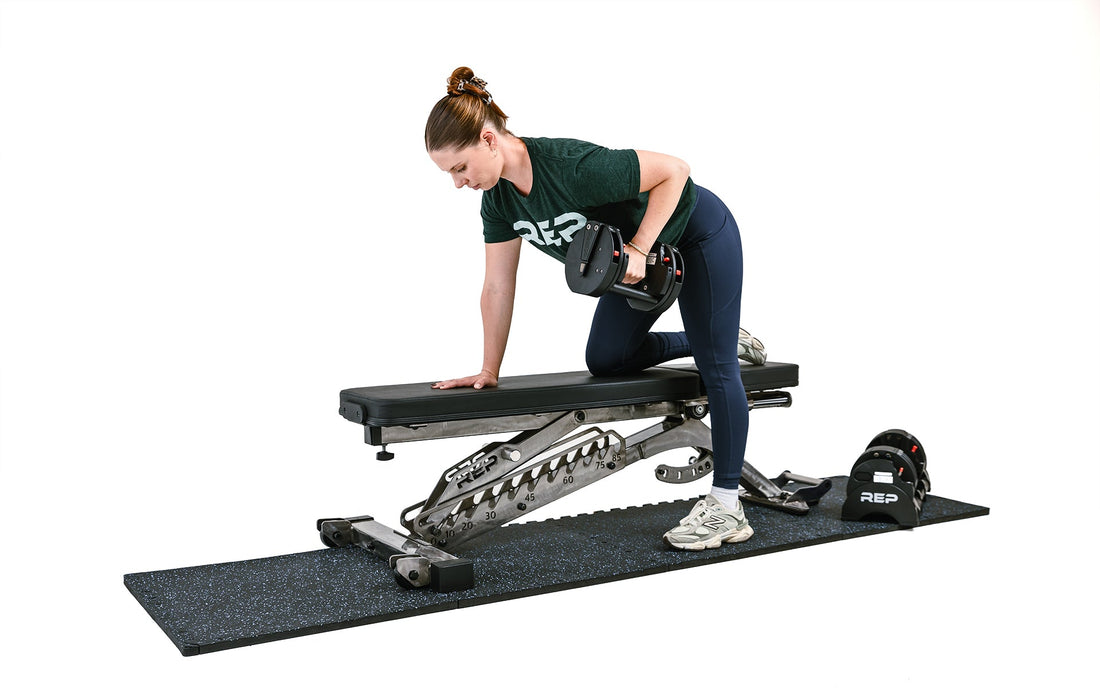
The gym flooring you select is crucial to creating the ideal workout environment, as it impacts everything from safety and durability to ease of maintenance.
While there are various materials to choose from, rubber remains the top choice for both home gyms and commercial spaces due to its exceptional performance. Within rubber flooring, there are different types, including interlocking tiles and roll flooring, each offering unique benefits depending on your specific needs.
Let’s break down the key differences to help you make the best choice for your gym.
Interlocking Tiles vs. Roll Flooring
Interlocking tiles are designed with versatility and convenience in mind. These tiles, often made of rubber or foam, snap together like puzzle pieces, allowing for easy installation without the need for adhesives. This makes them an excellent choice for home gyms or facilities that may need to reconfigure their layout or relocate in the future.
The modular nature of interlocking tiles means you can customize the size and shape of your flooring area to fit any space. They’re also simple to replace if one tile gets damaged—just pop out the old tile and snap in a new one. However, the seams between tiles can sometimes collect dirt or moisture, and depending on the thickness and material, they may not provide the same level of durability as roll flooring.
Roll flooring, typically made from heavy-duty rubber, offers a seamless look that is both durable and aesthetically pleasing. Unlike interlocking tiles, roll flooring covers large areas with fewer seams, reducing the chances of dirt and moisture accumulation. This makes it a great option for commercial gyms or high-traffic areas where cleanliness and longevity are priorities.
Installing roll flooring can be more labor-intensive than interlocking tiles; it may require adhesive for a secure fit. However, once installed, roll flooring provides a stable, continuous surface that’s excellent for heavy lifting, high-impact activities, and even heavy cardio equipment. Its durability is unmatched, withstanding wear and tear over time, making it a long-term investment for serious gym environments.
Which Gym Flooring Is Right for You?
The choice between interlocking tiles and roll flooring ultimately comes down to your specific needs. If you value flexibility, ease of installation, and the ability to easily replace sections, interlocking tiles may be the way to go.
On the other hand, if you’re looking for a seamless, durable surface that can handle heavy use and provides long-term reliability, roll flooring might be the better option.
Both types offer unique advantages, so consider the demands of your space and choose the option that best meets your gym’s needs.
Why Rubber is the Best Gym Flooring
Rubber flooring is incredibly resilient, designed to absorb impact from heavy weights, protect your floors, and reduce noise. It’s also easy to clean and maintain, ensuring your exercise room remains hygienic and inviting. Plus, rubber is protective and absorbent—without losing its shape over time.
Here are 10 reasons why rubber is the best gym flooring:
- Durability: Rubber flooring withstands heavy weights and high-impact activities without damage, ensuring it lasts for years.
- Shock Absorption: It cushions impact, protecting both floors and equipment from damage, which is crucial for high-intensity workouts.
- Noise Reduction: Rubber significantly reduces noise from dropped weights, creating a quieter gym environment that’s more pleasant for everyone.
- Slip Resistance: The non-slip surface of rubber flooring reduces the risk of injuries, making it safer for all types of exercises.
- Low Maintenance: Rubber flooring is simple to clean and maintain, helping you keep your gym hygienic with minimal effort.
- Versatility: Suitable for a wide range of workouts, from weightlifting to cardio, rubber flooring adapts to different exercise needs.
- Comfort: Rubber provides a comfortable surface for exercises that involve floor work, offering cushioning that’s easy on your joints.
- Aesthetic: Available in various colors and designs, rubber flooring can match the look and feel of your gym, adding to its overall appeal.
- Environmentally Friendly: Often made from recycled materials (especially floors with recycled fleck), rubber flooring is a sustainable choice for eco-conscious gym owners.
- Cost-Effective: With its long-lasting performance, rubber flooring offers great value over time, making it a smart investment for any gym.
The Best Rubber Gym Flooring
Among the many options available, REP’s Commercial Flooring Rolls, Gray Fleck Puzzle Tiles, and Rubber-Topped Foam Flooring Tiles (coming soon!) stand out as superior choices for gym flooring.
-
Commercial Flooring Rolls:
This high-density, seamless flooring is perfect for commercial gyms. It comes in various thickness options (8mm, 9mm, 12mm), allowing you to choose the right level of support for your needs. The 4’x25’ rolls cover large areas efficiently, simplifying installation. The durable material is built to withstand regular wear and tear, making it ideal for heavy lifting and intense workouts even in busy gyms.
-
Gray Fleck Puzzle Tiles:
These tiles are an excellent choice for home gyms, featuring a 10% fleck design that hides dirt and debris. Lightweight and easy to install, Gray Fleck Tiles provide excellent protection and durability, ensuring your gym looks clean and polished. Their environmentally friendly construction adds to their appeal, making them a sustainable choice for your gym. This is the best, toughest option for your home gym.
-
Rubber-Topped Foam Flooring Tiles (coming soon!):
Ideal for home gyms, these tiles combine durability with comfort, featuring a firm rubber top and a cushioned foam bottom. They are easy to install and come in stylish designs that enhance your gym’s look, offering both protection and aesthetic appeal. Go with these if you want a slightly softer, more cushioned floor ideal for floor exercises, yoga, stretching, and less rigorous barbell work.
-
4’x6’ Floor Mats:
These mats are made from 100% recycled vulcanized rubber, offering a dense, non-slip surface that provides excellent shock absorption. Their large size and substantial thickness make them ideal for covering significant areas, protecting both your equipment and your floors. What sets these mats apart is their ability to withstand the rigors of intense workouts while providing a stable, supportive surface for all types of training.
-
3’x4’ Stall Mats:
Made from recycled rubber, these mats are tough enough to handle heavy weights and high-impact activities. Their unique size makes them easy to move and configure in various layouts, making them a great choice for smaller gym spaces or specific workout zones. The compact design doesn’t compromise on quality, providing a robust, shock-absorbing surface that’s perfect for protecting your floors and equipment.
-
Rubber Floor Tiles:
These interlocking tiles are crafted from high-quality rubber, providing a seamless and secure fit that’s easy to install and rearrange as needed. The tiles feature a non-slip surface that’s perfect for all types of exercises, from weightlifting to cardio. What makes these tiles unique is their modular design, allowing you to cover any size space with precision and ease. The ability to replace individual tiles also ensures your gym floor stays looking and performing its best, even in high-traffic areas.
Other Types of Flooring To Avoid
While rubber is the best gym flooring, other types of flooring are commonly used but have significant drawbacks. Please don't use these. They are no good.
- Carpet: Carpet might seem like a soft and comfortable option, but it lacks the durability and support needed for gym activities. It can also absorb sweat, leading to unpleasant odors and potential mold growth. Gross.
- Vinyl: Vinyl flooring is easy to clean and inexpensive, but it’s not as durable as rubber. It can wear down quickly under heavy use and doesn't provide as much protection for your equipment or joints.
- Hardwood: Hardwood flooring is aesthetic and durable in general, but it's not ideal for a gym. It can be slippery, and heavy weights can cause dents or scratches. It also lacks the shock absorption needed for high-impact exercises.
So What? Why Proper Gym Flooring is Important
Don’t skip it. Proper gym flooring is important for several reasons:
- Safety: A good gym floor reduces the risk of injuries by providing a stable, non-slip surface that can absorb shock and impact.
- Equipment Protection: Quality flooring helps protect your gym equipment from damage, especially when dealing with heavy weights or machines. You went to all this work to buy and set up your gym; take care of it, kids.
- Floor Protection: Gym flooring prevents damage to the underlying floor, whether it's concrete, wood, or tile, by distributing the weight and impact evenly.
- Noise Reduction: Rubber flooring is excellent at dampening noise, making your workout space quieter and more comfortable for everyone around. Even the neighbors.
Learn more! Let's talk about gym flooring here.
What is the Best Thickness for Gym Flooring?
The ideal thickness for gym flooring depends on your workout needs:
- 8mm: Suitable for standard home gyms where heavy weights aren't frequently dropped. This thickness provides a good balance between comfort and protection.
- 9mm: Ideal for home or commercial gyms where weights might occasionally be dropped. It offers additional protection for both the floor and the equipment.
-
12mm: Best for commercial gyms or spaces where Olympic lifting or high-impact exercises are common. This thickness provides maximum shock absorption, making it ideal for areas where weights are regularly dropped.
Learn More About Gym Flooring
- The Floor is Yours: Let's Talk About Gym Flooring
- REP's Flooring Collection
- How to Install and Maintain Gym Flooring
-
How to Clean Your Rubber Gym Floor
Aimee Heckel, CPT, is a health and fitness journalist with over 20 years of experience. She set an all-time world-record deadlift in her division across all powerlifting federations at Mr. Olympia. In addition, she earned a national deadlift record and 18 Colorado state records. Heckel also has nine world records in grip sport, a pro card in natural figure bodybuilding, four first-place bodybuilding titles, and was named IPE Ms. Colorado Figure.
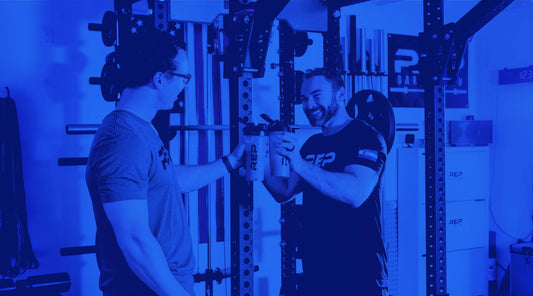
NEWSLETTER SIGNUP
Product launch information, promotions, blogs, and REP news.

